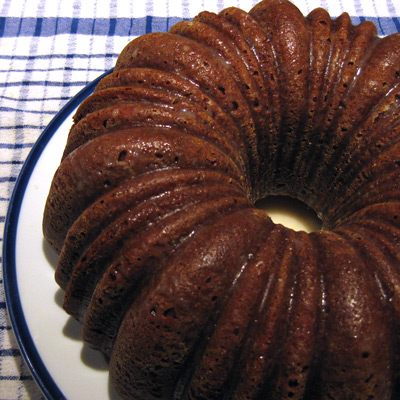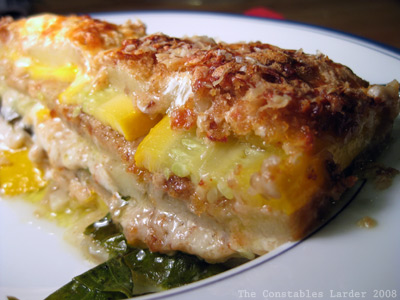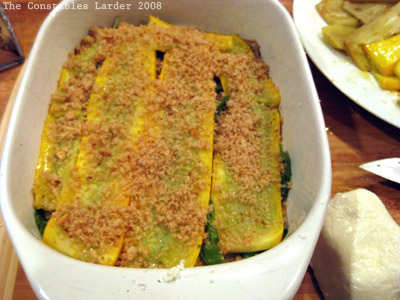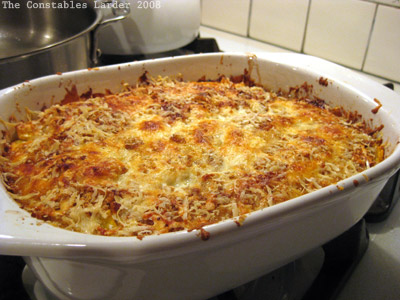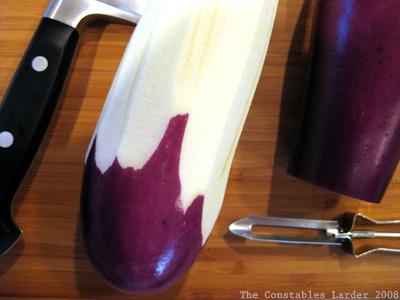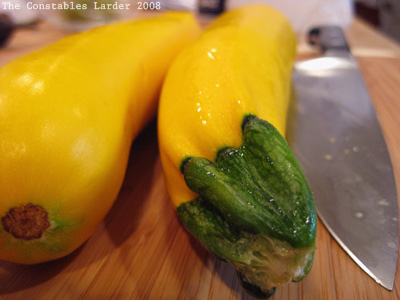(part of From Provence to the Catskills, our celebration held as part of of the Foodbuzz 24, 24, 24 blog event)
Following on from Elizabeth David, Richard Olney was assigned the entrée (in the French meaning of the term). Flipping through his cookbook Simple French Food for inspiration, I came across this description: “one of these little puddings, prelude to an amicable chunk of rare meat, might take many a jaded gastronome by surprise.” Well, zucchini are abundant at Gill’s farmstand, and our menu certainly included an “amicable chunk of meat,” so Dick’s zucchini pudding soufflés sounded just the ticket.
Well, delicious it certainly was, but as a soufflé, it was something of a flop (pardon the pun), hence the renaming of the recipe. As an aside, if you’re ever tempted to cook from Richard Olney, bear in mind that “simple” is a complete oxymoron for this publication. Any recipe that reads in part “prepare the béchamel as usual” with no further guidance is not for the novice. These recipes also require a fair bit of stamina and concentration.
Zucchini Puddings
Zucchini:
1 lb of zucchini
Salt
2 tbs butter
Béchamel
2 tbs butter
3 tbs flour
¾ cup milk
3 eggs, separated
Salt/pepper
Sauce
2/3 cup tomato puree (home made – see below)
1 cup heavy cream
1/2 cup freshly grated Parmesan
The first step is to prepare the zucchini: grate about one pound of peeled zucchini (Olney recommends hand-grating or using a Mouli-julienne, but he was writing in 1974; two cycles of the Cuisinart saved me about 2 hours). Arrange the grated zucchini in layers in a bowl, sprinkling each layer with salt, and let stand for 30 minutes. Then work the zucchini with your hands to get the liquid out of it: squeeze it repeatedly “until it is swimming” in juice, strain it a couple of times through a sieve, and press well “to rid it of flagrant moisture.” This is a fairly labor-intensive step and takes a while to get the zucchini properly dried out. Next, sauté the zucchini over a medium flame in a generous amount of butter (well, it is French cooking) until well dried out and starting to color, about 10 minutes.
Preheat the oven to 350F.
Next, the béchamel. In a saucepan over a medium flame, melt the butter, add the flour and stir with a wooden spoon for a minute or two to make the roux. Turn down the heat and add the milk to the roux a little at a time until well combined (this works best if the milk is warmed up for about a minute in the microwave first. Continue to stir until thick and creamy – this will happen fast with only 3/4 cup of milk. You can also use a whisk to keep the sauce free of lumps. Remove the saucepan from heat as soon as the béchamel has thickened and let it cool slightly. Then, mix in the 3 egg yolks one at a time. Season with salt and pepper. Then stir in the cooked zucchini.
In a mixing bowl, beat the egg whites until stiff peaks form. Add about a third into the béchamel/egg/zucchini mixture to loosen it up, then gently fold in the rest of the beaten egg whites. Take care with this step – do not let yourself become too distracted by interesting political conversations or attention-seeking 3-year-olds and over-mix the egg whites, or the puddings will not rise and you will have to change the name of the dish from souffle to pudding. Don’t worry if you do – they will still taste good.
Pour the mixture into well-buttered ramekins (or a single larger souffle dish). Place the ramekins in a large shallow baking dish. Pull out the oven rack half-way, put the dish on the rack and then pour in enough boiling water to immerse the ramekins to two-thirds of the way up the sides (a bain-marie). Cook at 350F for 20-25 minutes, until the surface of the puddings is firm and springy to the touch. Take ramekins out of the bain-marie and allow to cool for 10 minutes.
Turn the oven up to 450F.
While the puddings are cooling, make the tomato sauce: whisk together the tomato puree and cream, season with salt, pepper, cayenne. You can used canned puree, or make your own as we did by cooking up 2 tins of skinless plum tomatoes, a handful of basil and several sprigs of oregano, a few pinches of salt and sugar. Bring this to a boil, then simmer for an hour. Run this through the food mill, then cook it down further for another hour or two until it has a nice thick consistency (this yields much more than you need for this recipe, but tomato puree is quite useful to have around, so we made extra).
Turn the puddings out of the ramekins and return them to a baking dish large enough to hold all of them comfortably. Pour over enough tomato sauce to coat the puddings well, allowing the sauce to run down around them in the dish. Top with grated parmesan cheese and return to the oven for 20 minutes or so, until the surface is browning and the sauce bubbling. Plate and serve, spooning some of the tomato sauce around the puddings.
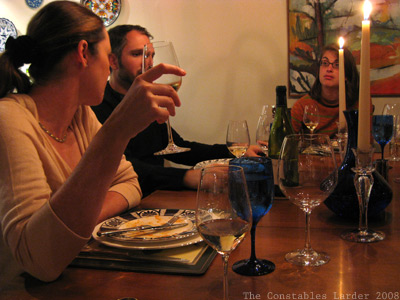
We served this with a viognier wine with decent acidity. The puddings (aka souffles) might not have puffed up to full glory, but they disappeared quickly from the plates.
